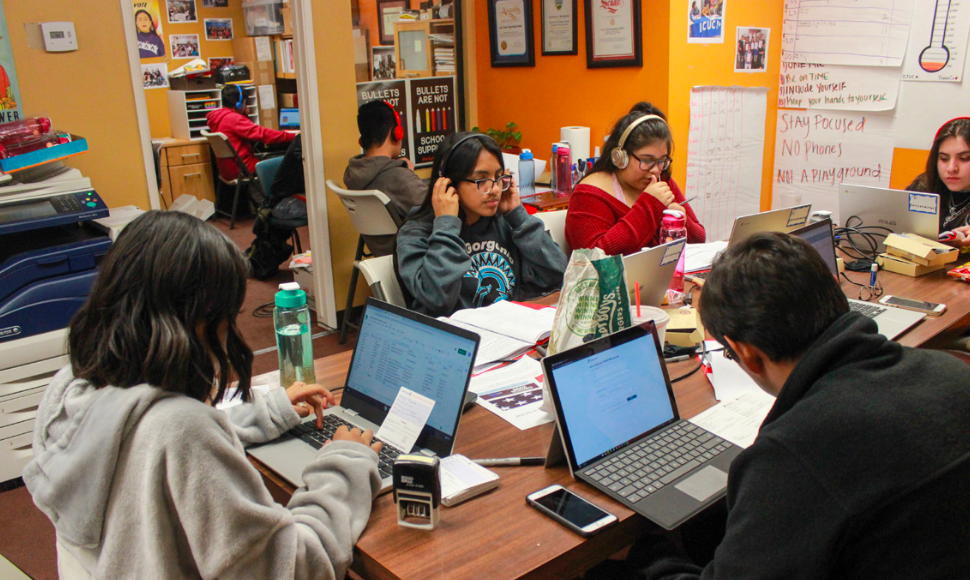Youth at the starting line
The complex issues addressed by the People’s Plan all affect youth and young adults in specific ways. People who are working to establish themselves economically in our communities are given difficult choices about how to support themselves and their families because of the economic problems in San Bernardino.
Youth Action Project (YAP) assists youth and young adults who are facing barriers to employment and academic opportunities. Our target population ranges in age from 14 to 24 years-old and includes high school, college, and university students / recent graduates, justice-involved youth and opportunity youth between the ages of 16-24 that are neither enrolled in school or employed.
The lack of transportation, a lack of affordable housing, the high costs of certification and licensing programs, poor treatment by employers, and unsafe working environments, are just a few of the barriers faced by the people we serve. These issues are frequently made worse by issues such as lack of a steady income, unstable living arrangements, and a lack of post-secondary education. The group we identified and worked with for this research consisted primarily of those identifying as Latinx and African-Americans, with a smaller group of participants identifying as White. The ages of the participants ranged from 17 to forty, and their household income at time of participation was less than $50,000. One hundred percent of those who took part lived in San Bernardino.
YAP advocates for policies that improve economic opportunities through workforce development, youth development, and academic achievement. For over two decades, Youth Action Project has provided transformative experiences, professional development training, career coaching, and paid work experience to youth and young adults, allowing them to discover their passion and develop marketable skills for the workforce. This section will highlight some of the key findings from the Just SB collaborative research project. These findings indicate that we are still a long way from having an equitable and accessible workforce for our youth and young adults in San Bernardino. In the last section, we offer several recommendations in support of the development of affordable credential programs and the accessibility of career pathway opportunities based on partnerships between local employers, institutions of higher education, and community-based organizations.

Engaging youth: Survey Findings
To gather survey responses, YAP collaborated with college students, community members, and influencers. Our process included weekly strategy meetings to review survey collection metrics and adjust our outreach strategy as needed. The geographic regions canvassed included local colleges, supermarkets, gas stations, shopping centers, and unincorporated regions with limited transportation, such as the community of Muscoy in San Bernardino County. Additionally, YAP attended multiple community events where large volumes of survey respondents could be targeted. YAP assisted in the development of several survey questions pertaining to workforce, higher-ed, access, and income. The following is a summary of key findings:
In response to question 18 of the survey, “What is your highest level of education”, the majority of individuals surveyed stated that they lacked post-secondary degrees that might open doors to careers with sustainable incomes. One respondent explained that, “I dropped out of Valley College because I needed a job.” Our survey also found that, as the cost of living in our communities increases, the majority of residents do not have the financial means to remain in their communities long-term.
In response to our question about yearly income, the vast majority of survey respondents stated that they earned less than $50,000 annually. And, in response to our question on whether or not their household incomes had changed over the last three years, the majority of our participants stated that their households did not see a significant increase in income. In fact, many saw their economic situation deteriorate over the most recent three years.

Youth are leaders of now
Youth Action Project conducted multiple focus groups at various community locations and worked in collaboration with our partners for the greatest reach and accessibility.
Many participants reported feeling energized, while others communicated nervousness about their participation. There were several emotional moments during the focus groups, as participants allowed for a level of vulnerability as a result of their candid responses. It is important to mention that the vast majority of our participants stated that they had never been asked the types of questions included in our focus groups before, nor had they ever been invited to participate in the creation of a local plan for their communities. Overall, respondents stated that they had a positive experience and expressed a desire for more opportunities to include community voices in regional planning.
“One of the issues that most families find important is tied to the employment challenges and opportunities. San Bernardino is no different, and one of the things we know in order for us to continue to thrive and grow as a community, we need strong employment opportunities here. So, we would like to know from you the residents of the San Bernardino community.”
- QUESTION #1
“In your opinion, what are some of the biggest challenges to getting quality employment in San Bernardino and what are some areas of employment opportunities you have seen or experienced in San Bernardino?”
One self-identified Latino participant explained to the group that, “I gotta have two jobs to support my livelihood right. I support a family of three so one job isn’t enough, not on 10 hours, so I gotta get another job. Honestly, health wise it’s really bad because, for my example, that pressure for me being on top of my work drove me to depression.” Another participant, also a self-identified Latino, added, “When I was working in the warehouses it was really hard to break the cycle out of that career. Once you have warehouse under your name it’s hard to move into a different part. It’s an abusive cycle.” With regards to her experience, a self-identified Black woman told the group that, “I grew up in San Bernardino but you best believe I was going to make my way out of San Bernardino. I didn’t see any example of what success look like to me.” Lastly, a self-identified Latina explained to the group that “I purposefully look for work somewhere else just because I don’t feel safe here (San Bernardino) sometimes.”
- QUESTION #2
“In what ways does the education system or local educational opportunities support (or limit) San Bernardino residents in their efforts to improve their economic situation, move up in their jobs or careers, and have a better quality of life?”
A self-identified Black female in the group explained, “No one sat me down when I was in high school. I had to literally do the research myself…if we don’t have the examples, the mentors, it definitely sets you back.” A self-identified Latina participant shared her experience and stated that, “students are always tired, always exhausted trying to get AP classes, it was the workload and they were expected to get good grades. They can’t even take time for themselves… eventually you can’t sustain that.” And, a self-identified Latino participant shared his opinion; “I believe the curriculum is due for a change.”
Solutions through a youth lens
-
These surveys and focus groups have assisted us in imagining policies that promote equity, accessibility, and long-term sustainability. Using the findings of this research, we were able to identify access to better transportation for our participants as a key recommendation. It was also clear that we need to modernize our 211 information services with applications and simple navigational tools, as well as workshops to teach individuals how to browse the resources and apply for jobs.
Another policy or programmatic recommendation that we see as an opportunity to improve an accessible workforce with equitable and inclusive practices is a cohesive and responsive partnership with industry, small businesses, schools, and non-profits that would help increase communication between sectors and build a more comprehensive model to better bridge the opportunity gap for our marginalized communities.
Our youth and young adults should not have to be the primary breadwinners for their families, working multiple jobs to make ends meet. Our youth should not have to relocate for better opportunities.
In conclusion, to better prepare our communities for better job and career opportunities, YAP is redesigning an internal workforce curriculum. YAP has been developing new partnerships to help provide transformative experiences for youth and young adults, as well as professional development training, career coaching, and paid work experience, allowing youth and young adults to discover their passions and develop marketable skills for the workforce.
Recommendations Summary:
- Access to better transportation
- Modernize our 211 information services with applications and simple navigation tools
- Workshops to teach individuals how to browse the resources and apply for jobs
- Cohesive and responsive partnership with industry, small businesses, schools, and non-profits that would help increase communication between sectors and build a more comprehensive model to better bridge the opportunity gap for our marginalized communities